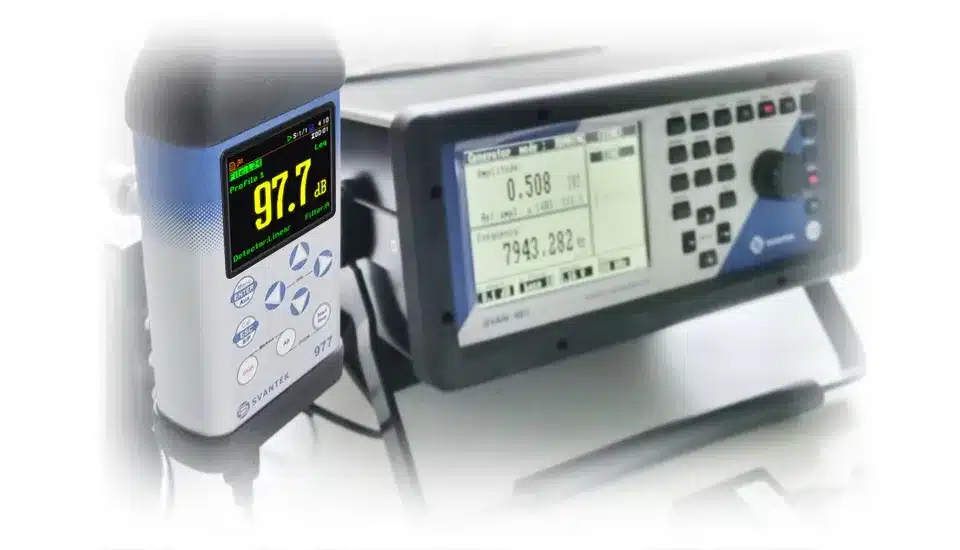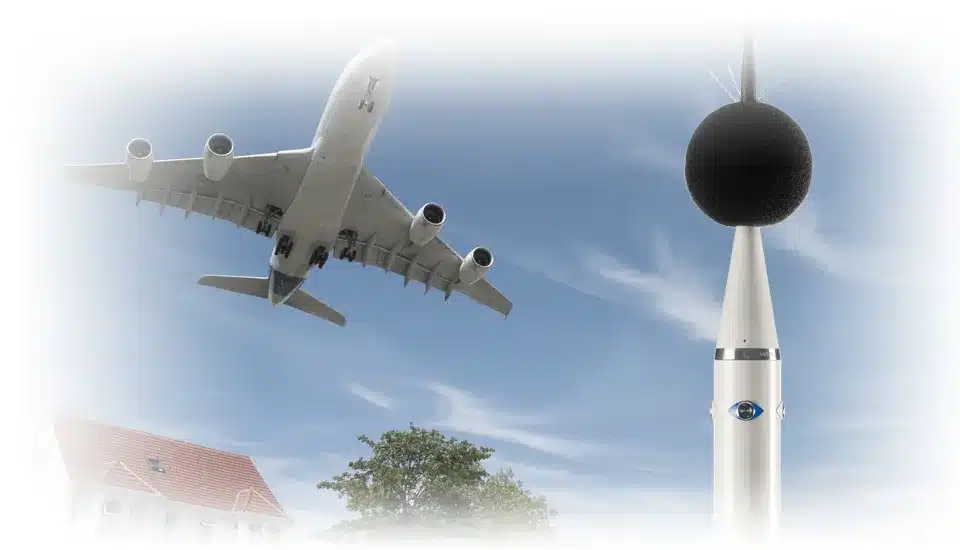What are acoustic measurements?
Acoustic measurements are a set of measurement methods that allow you to determine acoustic parameters. We perform acoustic measurements using a meter equipped with a microphone or an acoustic probe. Acoustic measurements include measurements of the acoustic parameters of rooms, noise measurements, or measurements of acoustic power or emission levels. Additionally, when considering acoustic measurements, one should not forget about vibration measurements, which are also largely related to acoustics.
What are vibration measurements?
Vibration measurements are measurements of mechanical vibrations made using a meter with an attached vibration transducer. We perform vibration measurements in the case of machine diagnostics, assessment of the impact of vibrations on structures and people inside buildings, as well as for measurements of vibrations transmitted by the upper limbs and general vibrations acting on humans.


How are acoustic measurements different from vibration measurements?
Acoustic measurements are made using a sound level meter equipped with a microphone and consist of measuring the parameters for which the sound is responsible. We perform vibration measurements using a meter with a vibration transducer. During these measurements, the acceleration and frequency of vibrations are most often measured.
Why make acoustic and vibration measurements?
Acoustic and vibration measurements allow you to control the safety of people working with exposure to noise and vibrations. In accordance with the regulations, these measurements should be performed regularly. On the basis of acoustic measurements of rooms, it is possible to prepare an acoustic design or determine acoustic problems in a given room. In addition, vibration measurements also allow for the protection of buildings that may be exposed to vibrations in connection with, for example, renovation.

How to perform noise measurements?
Noise measurements should be made with appropriate measuring equipment with an estimated uncertainty. Most often, sound level meters or vibration meters are used for this. Svantek offers professional meters that meet the relevant normative requirements. To be sure that the measurements have been made correctly, it is worth using accredited measurement laboratories.
Can I make noise measurements myself?
A very indicative measurement, giving an overall view of the acoustics in the room, can even be done using the phone’s noise measurement app. There are also many sound meters on the market that do not meet the requirements of the standard. They are used to perform loudness measurements for their own, non-professional needs. However, taking measurements with such equipment has nothing to do with accredited measurements that meet the normative and quality requirements.


Who can perform acoustic measurements?
There are many companies that deal with acoustic measurements. No authorization to perform such measurements is required for acoustic and vibration measurements. However, companies often employ specialists with specialized education, because, in addition to the measurement itself, it is necessary to develop the results and appropriate analysis. The most correct choice of a measurement company is to choose an accredited unit.
What is accreditation?
By definition, accreditation is “granting a power of attorney”. The Center for Accreditation grants accreditation to a laboratory that is competent to perform appropriate measurement procedures. For the purposes of accreditation, it is necessary for the laboratory to develop measurement procedures, demonstrate the correctness of their implementation, estimate measurement uncertainties and meet the quality requirements related to customer service, equipment supervision, etc.


Why are noise and vibration measurements accredited?
Accredited laboratories have the power to declare compliance with the normative requirements in their documents. Thanks to the accreditation, the customer has a guarantee that the measurements were made in accordance with the guidelines of the standards and the results of these measurements can be the basis for further actions.
Who can perform accredited noise measurements?
The database of all accredited units is usually available at the local Center of Accreditation websites. There you can find all the laboratories in a given location or carry out measurements in a specific field of research. The scope of accreditation of each laboratory is also generally available. Scopes of accreditation are documents that contain information about the test subjects of laboratories and the measurement methods that are used in a given laboratory.

What are the noise measurement methods?
Depending on the specific sound source and the purpose of the measurements, the measurement methods may differ from each other. For the purposes of measuring noise from traffic, indicators such as Lden are often defined, and for the measurements of acoustic parameters of rooms, the reverberation time or speech intelligibility are measured. In rooms that must meet the requirements of the Building Law, the insulation performance of walls, doors, and windows should also be measured. It is similar in the field of vibrations, where we measure whole-body vibrations, hand-arm vibrations, vibrations of machines, or vibrations affecting buildings. In each of these cases, different parameters can be measured for other specific frequencies. In addition, emission measurements are very common for industrial noise.
What are emission measurements?
Emission measurements are measurements of the noise that is generated by a device or installation on the premises of an industrial plant. The requirements for measuring emission levels include defined methodologies for measuring such noise periodically.
How can noise and vibration measurements protect the environment?
Thanks to environmental noise measurements, it is possible to identify places where residents may be exposed to high noise levels. It is a starting point for the preparation of appropriate acoustic maps and thus for starting procedures related to noise reduction in a given place. Lower noise means, above all, greater comfort for residents. Vibration measurements allow for the determination of vibration exceedances within the construction industry. Therefore, thanks to such measurements, we can avoid unwanted ground movements, which may later cause cracks or damage to the structure.

Workplace Noise
What are the standards for noise at work measurements?

The frequency of measurements at workplaces along with noise and vibration limits are specified in the local regulations. International standards such as ISO 9612 provide a set of measurement techniques for the noise assessment and instrumentation to be used for measurements.
How to perform noise measurements at the workplace?

For noise, measure the level of noise exposure related to the 8-hour daily working time or the level of noise exposure related to the working week, as well as the peak sound level C. For hand-arm and whole-body vibrations, the daily exposure to 8 hours is determined.
Aircraft noise
What are the standards for aircraft noise measurements?

The frequency and methodology of measurements at airports are specified in the local regulations. There, the necessity to perform noise measurements periodically or continuously was defined there. International standards such as ISO 20906 provide a set of measurement techniques for the noise assessment and instrumentation to be used for measurements.
How to measure aircraft noise?

In the case of aircraft noise, it is necessary to perform periodic or continuous measurements. For periodic measurements, we calculate the LAeq indicators for the respective times of the day or night. This can be done by measurement or by calculation. In addition, the setting of the measurement points is also strictly defined. In order to correctly set the measuring points, it is necessary to consider the purpose of the measurements, the characteristics of noise sources, and the parameters of the terrain. In the case of continuous airport measurements, noise monitoring stations are used.
Noise from roads, railways and trams
What are the standards for noise measurements?

The methodology of measuring noise from traffic and railways in the environment, as for airports, is defined by the ISO 1996 standards. To perform the measurements, it is necessary to use a class 1 sound level meter, and a weather station.
How to perform noise measurements?

To measure noise from roads, railways and trams we measure the LAeq indicators for appropriate times of the day and night in precisely determined measuring points. In this case, it is necessary to consider the places where people are most affected by this noise. If noise barriers are already installed in a given area, this should also be taken into account. The measurement procedures in this case have many variables. The area in which the measurements are made can be diverse.
Measurements of acoustic parameters of interiors
The methodology for measuring interior acoustic parameters requires the determination of three acoustic parameters: the maximum value of the reverberation time for octaves; the minimum value of the speech transmission index; and the minimum value of acoustic absorption for 500, 1000, and 2000 Hz. These requirements are different for the three groups of rooms defined by the standard. The first group includes rooms for verbal communication, e.g., conference, court, lecture, and classrooms. For this group, we define the maximum reverberation time and the minimum value of the STI index, depending on the room volume. The second group includes other rooms for which speech intelligibility is not that important, e.g. halls, rooms in nurseries, and kindergartens. Here we only define the maximum reverberation time. The third group includes rooms such as large offices, call centers, cloakrooms, corridors, and hospitals. For this group, we define only the minimum acoustic absorption of the room.

